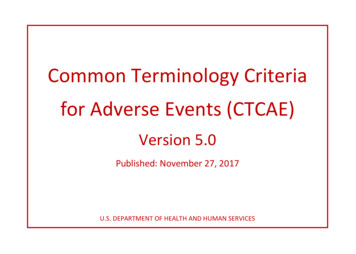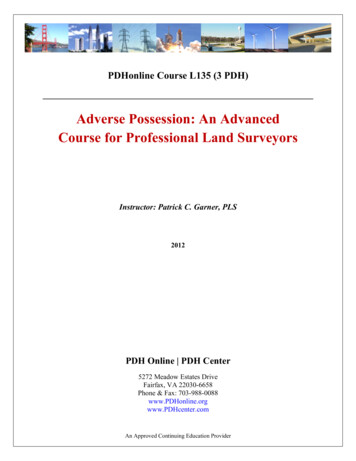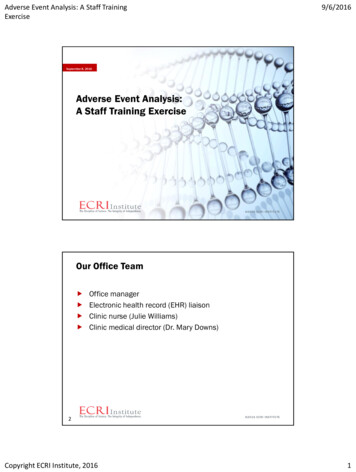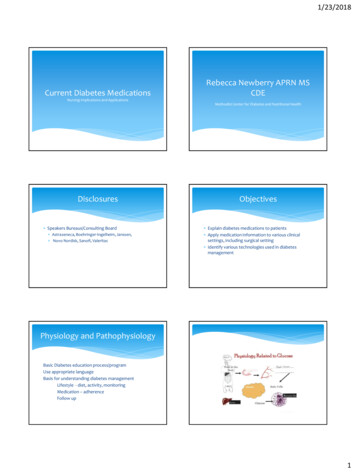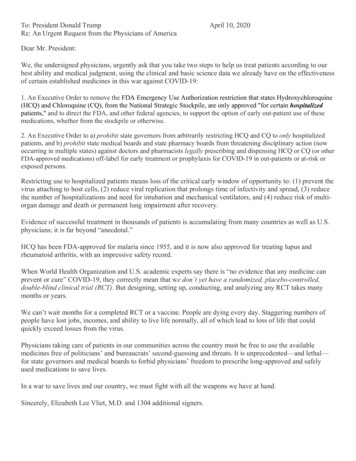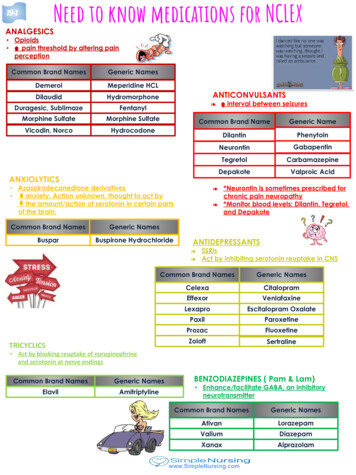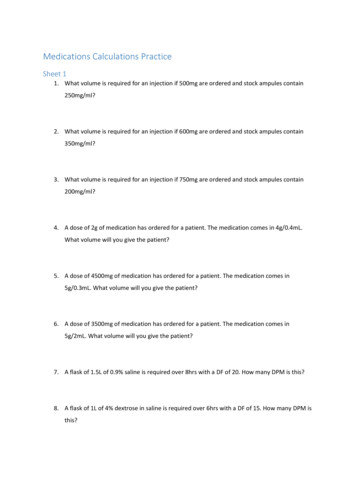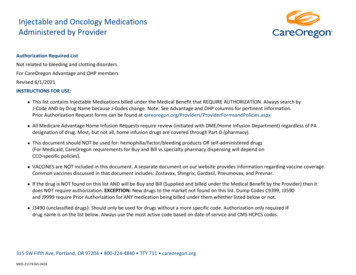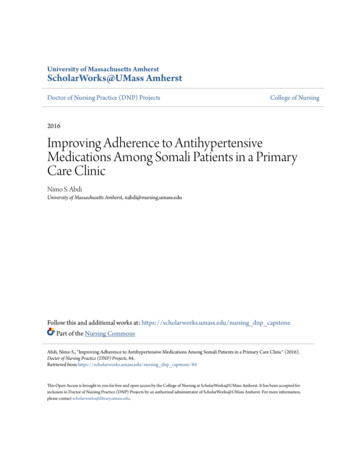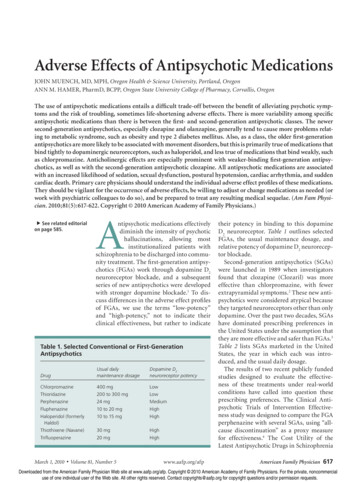
Transcription
Adverse Effects of Antipsychotic MedicationsJOHN MUENCH, MD, MPH, Oregon Health & Science University, Portland, OregonANN M. HAMER, PharmD, BCPP, Oregon State University College of Pharmacy, Corvallis, OregonThe use of antipsychotic medications entails a difficult trade-off between the benefit of alleviating psychotic symptoms and the risk of troubling, sometimes life-shortening adverse effects. There is more variability among specificantipsychotic medications than there is between the first- and second-generation antipsychotic classes. The newersecond-generation antipsychotics, especially clozapine and olanzapine, generally tend to cause more problems relating to metabolic syndrome, such as obesity and type 2 diabetes mellitus. Also, as a class, the older first-generationantipsychotics are more likely to be associated with movement disorders, but this is primarily true of medications thatbind tightly to dopaminergic neuroreceptors, such as haloperidol, and less true of medications that bind weakly, suchas chlorpromazine. Anticholinergic effects are especially prominent with weaker-binding first-generation antipsychotics, as well as with the second-generation antipsychotic clozapine. All antipsychotic medications are associatedwith an increased likelihood of sedation, sexual dysfunction, postural hypotension, cardiac arrhythmia, and suddencardiac death. Primary care physicians should understand the individual adverse effect profiles of these medications.They should be vigilant for the occurrence of adverse effects, be willing to adjust or change medications as needed (orwork with psychiatric colleagues to do so), and be prepared to treat any resulting medical sequelae. (Am Fam Physician. 2010;81(5):617-622. Copyright 2010 American Academy of Family Physicians.) See related editorialon page 585.Antipsychotic medications effectivelydiminish the intensity of psychotichallucinations, allowing mostinstitutionalized patients withschizophrenia to be discharged into community treatment. The first-generation antipsychotics (FGAs) work through dopamine D2neuroreceptor blockade, and a subsequentseries of new antipsychotics were developedwith stronger dopamine blockade.1 To discuss differences in the adverse effect profilesof FGAs, we use the terms “low-potency”and “high-potency,” not to indicate theirclinical effectiveness, but rather to indicateTable 1. Selected Conventional or First-GenerationAntipsychoticsUsual dailymaintenance dosageDrugDopamine D2neuroreceptor potencyChlorpromazine400 mgLowThioridazine200 to 300 mgLowPerphenazine24 mgMediumFluphenazine10 to 20 mgHighHaloperidol (formerlyHaldol)10 to 15 mgHighThiothixene (Navane)30 mgHighTrifluoperazine20 mgHighMarch 1, 2010 Volume 81, Number 5www.aafp.org/afp their potency in binding to this dopamineD2 neuroreceptor. Table 1 outlines selectedFGAs, the usual maintenance dosage, andrelative potency of dopamine D2 neuroreceptor blockade.Second-generation antipsychotics (SGAs)were launched in 1989 when investigatorsfound that clozapine (Clozaril) was moreeffective than chlorpromazine, with fewerextrapyramidal symptoms.2 These new antipsychotics were considered atypical becausethey targeted neuroreceptors other than onlydopamine. Over the past two decades, SGAshave dominated prescribing preferences inthe United States under the assumption thatthey are more effective and safer than FGAs.3Table 2 lists SGAs marketed in the UnitedStates, the year in which each was introduced, and the usual daily dosage.The results of two recent publicly fundedstudies designed to evaluate the effectiveness of these treatments under real-worldconditions have called into question theseprescribing preferences. The Clinical Antipsychotic Trials of Intervention Effectiveness study was designed to compare the FGAperphenazine with several SGAs, using “allcause discontinuation” as a proxy measurefor effectiveness.4 The Cost Utility of theLatest Antipsychotic Drugs in SchizophreniaAmerican Family Physician 617Downloaded from the American Family Physician Web site at www.aafp.org/afp. Copyright 2010 American Academy of Family Physicians. For the private, noncommercialuse of one individual user of the Web site. All other rights reserved. Contact copyrights@aafp.org for copyright questions and/or permission requests.
Antipsychotic MedicationsSORT: KEY RECOMMENDATIONS FOR PRACTICEEvidenceratingReferencesFGAs with lower potency dopamine D2 neuroreceptor blockade (Table 1) are no more likely thanmost SGAs to cause extrapyramidal symptoms.A4, 5, 9FGAs and the SGA risperidone (Risperdal) commonly cause hyperprolactinemia. Physicians shouldbe vigilant for signs and symptoms of hyperprolactinemia in patients taking these medications.C6, 19Patients taking SGAs, especially clozapine (Clozaril) and olanzapine (Zyprexa), should be monitoredclosely for weight gain and other metabolic syndrome–related adverse effects (Table 4).C39Antipsychotic medications should be used with caution in older adults because of the risk ofincreased mortality from sudden cardiac death and cerebrovascular accidents.A40-42Clinical recommendationFGAs first-generation antipsychotics; SGAs second-generation antipsychotics.A consistent, good-quality patient-oriented evidence; B inconsistent or limited-quality patient-oriented evidence; C consensus, diseaseoriented evidence, usual practice, expert opinion, or case series. For information about the SORT evidence rating system, go to http://www.aafp.org/afpsort.xml.Study measured quality of life and other effectivenessmeasures.5 Neither study demonstrated a clear differencein effectiveness between FGAs and non-clozapine SGAs.With the exception that clozapine is more effective fortreatment-resistant patients,6 the choice of antipsychoticshould depend on the potential for adverse effects in individual patients. General comparisons between the FGAand SGA classes are less helpful than comparisons amongspecific medications because each presents its own challenges in terms of balancing effectiveness with safety andtolerability. This article reviews some of the more important adverse effects of antipsychotics, and includes a summary table of the comparative risks (Table 3).6,7SedationSedation is common with antipsychotic medications andis dose related. It can be a cause of poor compliance and, ifpersistent, can interfere with social and vocational functioning. Many patients become tolerant to the sedativeTable 2. Atypical or Second-GenerationAntipsychotics Marketed in the United StatesDrugYearintroducedAripiprazole (Abilify)200210 to 30 mgClozapine (Clozaril)1989300 to 600 mgOlanzapine (Zyprexa)199610 to 20 mgQuetiapine (Seroquel)1998250 to 600 mgRisperidone (Risperdal)19943 to 6 mgZiprasidone (Geodon)200140 to 80 mgUsual daily dosagenote: Paliperidone, the active metabolite of risperidone, has beenmarketed in the United States as Invega since 2007. There is insufficient long-term clinical information on this medication to include itin this review. It is likely that the adverse effect profile of Invega willbe similar to that of risperidone.618 American Family Physicianeffect over time. Low-potency FGAs and clozapine arethe most sedating, with some effect from olanzapine(Zyprexa) and quetiapine (Seroquel).6 Somnolence canbe alleviated by lowering the dosage, changing to a singlebedtime dose, or switching to a less sedating medication.HypotensionOrthostatic hypotension can occur with all antipsychoticmedications, depending on the degree of α1-adrenoreceptor antagonism, particularly with low-potency FGAs andclozapine. It can also occur with risperidone (Risperdal)and quetiapine, especially with rapid titration. This effectis more common in older adults (with risk of falls), thoseon blood pressure medications, and those who have othercardiovascular diseases. With careful dose titration,patients may become tolerant to this effect. Treatmentoptions include decreasing or dividing doses or switchingto a medication with a lesser antiadrenergic effect.6Anticholinergic EffectsAnticholinergic effects include constipation, urinaryretention, dry mouth, blurred vision and, at times, cognitive impairment. These symptoms can lead to otherproblems such as tooth decay, falls, or gastrointestinal obstruction. Low-potency FGAs and clozapine arehighly likely to cause anticholinergic effects; olanzapineand quetiapine have been shown to do so at high dosages.8 When needed, doses can be lowered or divided tohelp alleviate this problem.Extrapyramidal SymptomsAntipsychotic medications cause four main extrapyramidal symptoms: pseudoparkinsonism, akathisia, acutedystonia, and tardive dyskinesia. The first three usually begin within a few weeks of starting a new medication (or increasing the dosage). These symptoms maycause discomfort, social stigma, and poor compliance.They are more likely to occur with higher dosages ofwww.aafp.org/afpVolume 81, Number 5 March 1, 2010
Table 3. Comparative Risk of Adverse Effects of Antipsychotic Medications*Adverse nergic effects ridone(Risperdal)Ziprasidone(Geodon) 0 00 0 0Extrapyramidal symptoms 0 0 Hyperprolactinemia 00 0 Neuroleptic malignantsyndrome Postural hypotension Prolonged QT interval § Sedation Seizures Sexual dysfunction Type 2 diabetes mellitus Weight gain 0 0note:0 rare; lower risk; medium risk; higher risk.FGAs first-generation antipsychotics; SGAs second-generation antipsychotics.*—Effects are approximate, and relative to other antipsychotic medications rather than absolute risk of an adverse effect occurring.†—FGAs with lower potency dopamine D2 neuroreceptor blockade, including chlorpromazine and thioridazine.‡—FGAs with higher potency dopamine D2 neuroreceptor blockade. These include fluphenazine, haloperidol (formerly Haldol), thiothixene (Navane),and trifluoperazine. Please note that the FGA perphenazine is considered to have intermediate dopamine D2 neuroreceptor blockade, with an adverseeffect profile between the low- and high-potency FGAs.§—Individually, thioridazine has a higher risk of prolonged QT interval and should be used only when no other appropriate options are available.Adapted with permission from Gardner DM, Baldessarini RJ, Waraich P. Modern antipsychotic drugs: a critical overview. CMAJ. 2005;172(13):17031711, with additional information from reference 6.high-potency FGAs, such as haloperidol (formerly Haldol), and are less likely with FGAs that have weakerdopamine blockade. Several meta-analyses, most comparing SGAs with haloperidol, have shown that SGAs areless likely to cause extrapyramidal symptoms.6 However,recent studies comparing SGAs with lower potency FGAshave not shown this sm is a reversible syndrome thatincludes tremulousness in the hands and arms, rigidity in the arms and shoulders, bradykinesia, akinesia,hypersalivation, masked facies, and shuffling gait. Thepresence of bradykinesia or akinesia can create a diagnostic dilemma, with symptoms resembling depressionor even the negative symptoms of schizophrenia (i.e., aninability to pay attention, the loss of a sense of pleasure,the loss of will or drive, disorganization or impoverishment of thoughts and speech, flattening of affect, andsocial withdrawal). Treatment options include dosageMarch 1, 2010 Volume 81, Number 5reduction or the addition of oral anticholinergic agents(e.g., benztropine, diphenhydramine [Benadryl]); physicians should keep in mind that these medications cancause their own adverse effects.AKATHISIAAkathisia is described subjectively as a feeling of innerrestlessness that can be manifested as excessive pacingor inability to remain still for any length of time. It canbe difficult to differentiate akathisia from psychiatricanxiety and agitation. Treatment of akathisia can includea dosage reduction when possible, or the addition of alow-dose beta blocker, such as propranolol (Inderal) at20 to 80 mg per day.10DYSTONIC REACTIONSDystonic reactions are spastic contractions of the muscles, including oculogyric crisis, retrocollis, torticollis,trismus, opisthotonos, or laryngospasm. These reactionsare uncomfortable and can be life threatening if leftwww.aafp.org/afp American Family Physician 619
Antipsychotic Medicationsuntreated. Intervention often requires administration ofintravenous or intramuscular anticholinergic agents.TARDIVE DYSKINESIATardive dyskinesia is an involuntary movement disorder that can occur with long-term antipsychotic treatment, and may not be reversible even if the medication isdiscontinued. Tardive dyskinesia usually involves theorofacial region, but all parts of the body can be involved.Abnormal movements can include myoclonic jerks, tics,chorea, and dystonia. They become most evident whenpatients are aroused, but ease during relaxation anddisappear during sleep.11 Risk factors for developing tardive dyskinesia include long-term therapy with FGAs athigher dosages, older age, female sex, and concurrentaffective disorders.6 Attempts to treat tardive dyskinesiausually begin by discontinuing the offending agent orswitching to one with a lower risk, but evidence is insufficient to show that this or any other treatment markedlyreduces symptoms after onset.12-18HyperprolactinemiaAntipsychotics cause high prolactin levels by blocking the normal tonic inhibition on pituitary mammotropic cells of dopamine produced in the hypothalamus.Hyperprolactinemia is common with the use of any FGA,as well as with the SGA risperidone (up to 60 percent ofwomen and 40 percent of men),19 and is dose dependent.It appears to be much less common with other SGAs, buthas been reported with the use of olanzapine and ziprasidone (Geodon) at high dosages.6Hyperpr
01.03.2010 · Adverse Effects of Antipsychotic Medications JOHN MUENCH, MD . schizophrenia to be discharged into commu-nity treatment. The first-generationantipsy-

